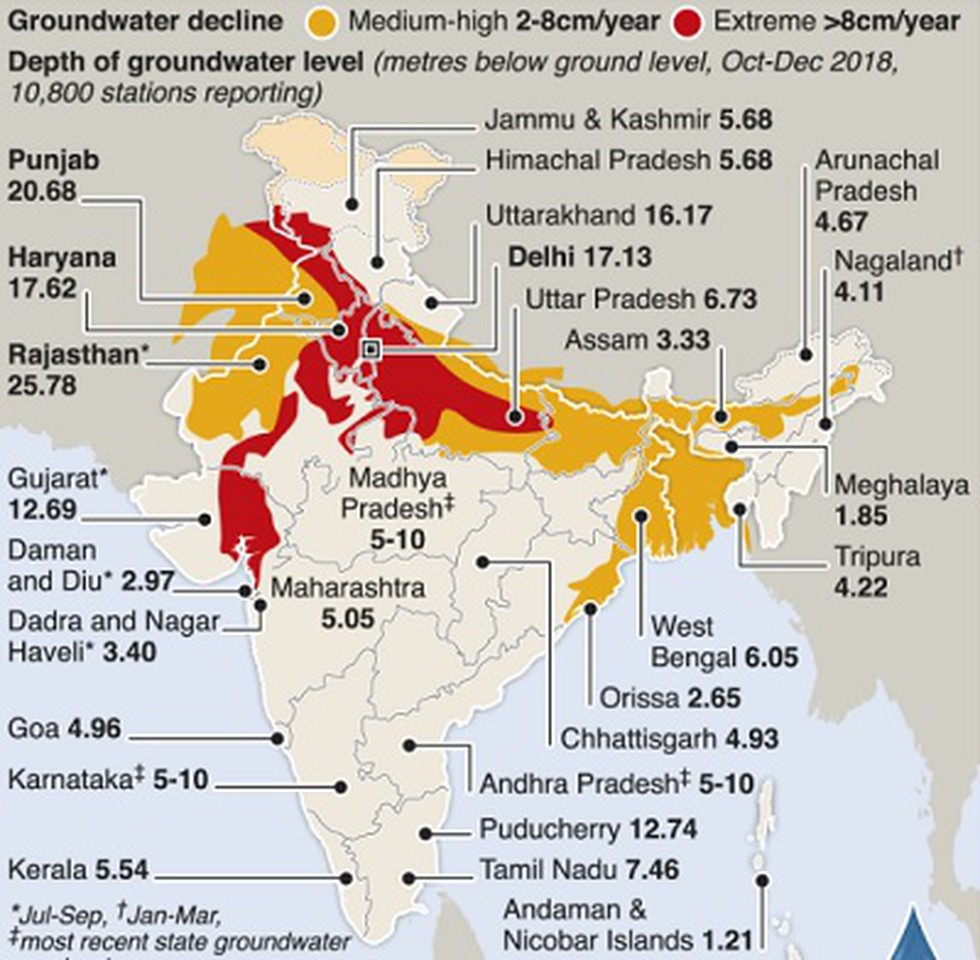India’s groundwater is not in a very good state. The annual recharge of water is far less than what is consumed. The situation is more alarming in urban areas due to population pressure and industrial growth, which in turn have led to increased water consumption.

Photo credit: Down to Earth
The total groundwater sources, which are annually recharged, provide around 43 million cubic metres (mcm) of water, out of which only 7 mcm is reserved for drinking and industrial purposes; 36 mcm is reserved for irrigation. The total need is assessed at 64 mcm at the end of the Eighth Five-Year Plan.
What is the situation in Delhi?
Delhi does not have enough clean water. The city needs 800-mega gallons per day (mgd) of water while it gets only 600 mgd. The Delhi government has to depend on the neighbouring states for the extra 200 mgd. The problem will become more acute in the near future because fresh water sources will decrease and the city will be surrounded by brackish and saline water. If the groundwater is exploited without being recharged, then it will also affect the fresh water. Even fresh water tubewells are now yielding brackish water. This means that the fresh water has been polluted. Moreover, there has been a likely increase of fluoride and nitrate content beyond permissible limits.
What are the obstacles in solving this crisis?
We have provided details of fresh water sources in the city to the Delhi Jal Board (djb). But they are very slow and instead of exploiting the sources that have been identified, the djb is depending on neighbouring states. Already a lot of damage has been done to Delhi because tubewells have been dug up without any proper technical advice. If this trend continues, then the potable water situation will worsen. On many occasions groundwater contamination has been due to the carelessness of the people and industries. Clear guidelines set by the Central Pollution Control Board (cpcb) have been violated repeatedly. We have to be strict with polluters if this problem has to be solved. We must also develop a mechanism to use polluted water for non-drinking and cooking purposes.

Photo credit: VajiRam IAS
One viable solution would be to go for recharging through rainwater harvesting. The excess water is not harvested even when there is a flood in the Yamuna. However, we are working to utilise this floodwater. We will make a deep well through a channel and push the water deep inside. It will act as a storage tank. It will also help in reducing the concentration of fluorides and nitrates.
The CGWA has recently come out with artificial recharging of groundwater.
Artificial recharging can ease the groundwater crisis because it helps in protecting water resources and assures a constant supply of clean water. The cgwa is analysing different workable and cost-effective recharging technologies. After the project is completed, we will demonstrate its effectiveness in various government buildings and institutions.
Roof-top water harvesting structures have already been implemented at the Indian Institute of Technology, New Delhi. Around 50 mcm of water can be kept in reserve by storing the excess water during rainy season. We need to maintain a constant water level. We have already taken initiatives to make residents aware about the grim scenario and the possible solutions.
Do you think there is any need to change the water policy?
I don’t think so. We have enough water. We only need to manage the available water resources properly. Instead of developing big water systems, we should go for smaller ones. In other words, we should decentralise the water system. Different areas should have their own water system so that it can be managed properly. At least we can try it on an experimental basis in some areas.
Vardhman Envirotech
India’s Passionate rainwater company
This article is published on: Down to Earth, 30 June, 1999
We would like to spread this for the benefit of fellow Indians.
